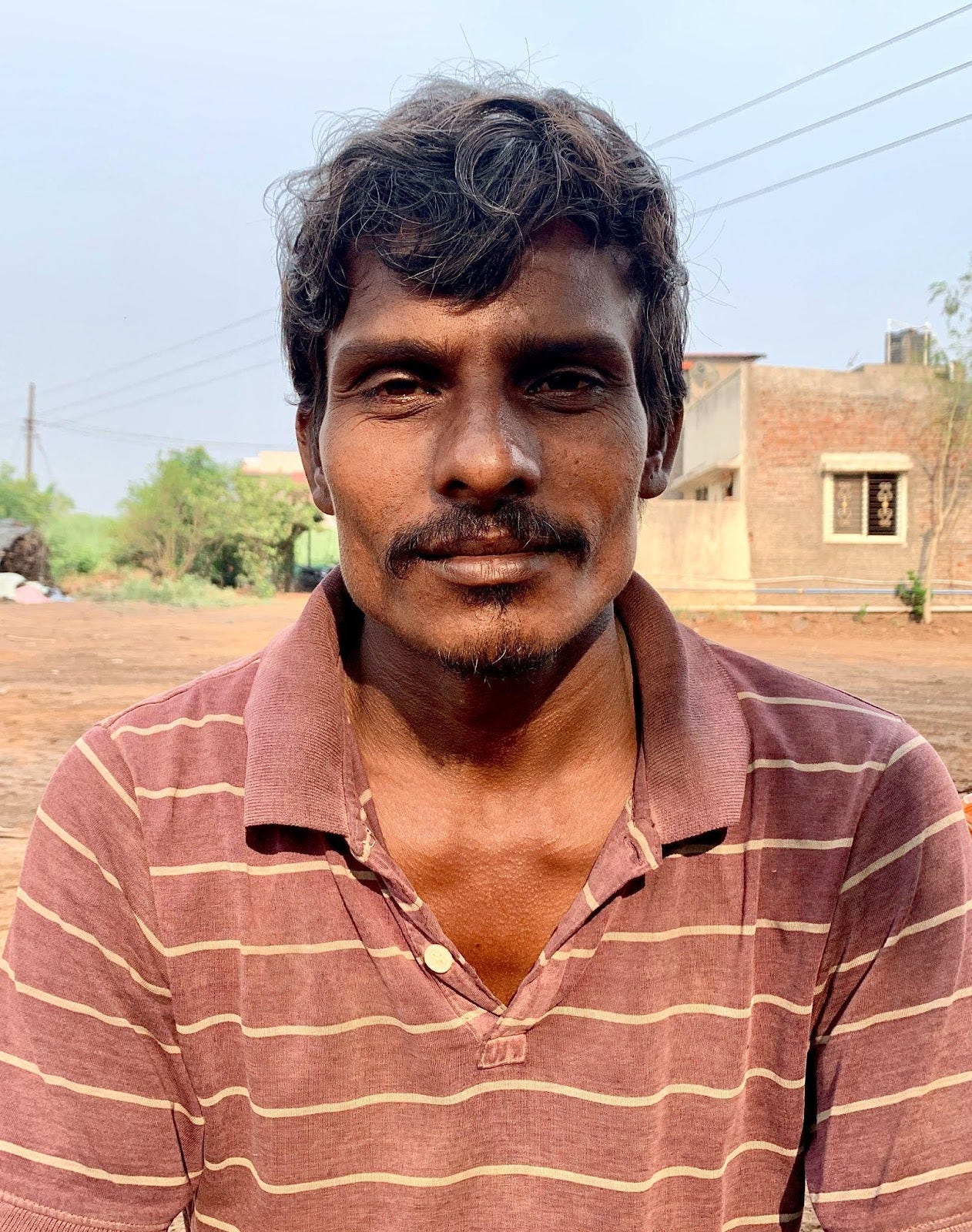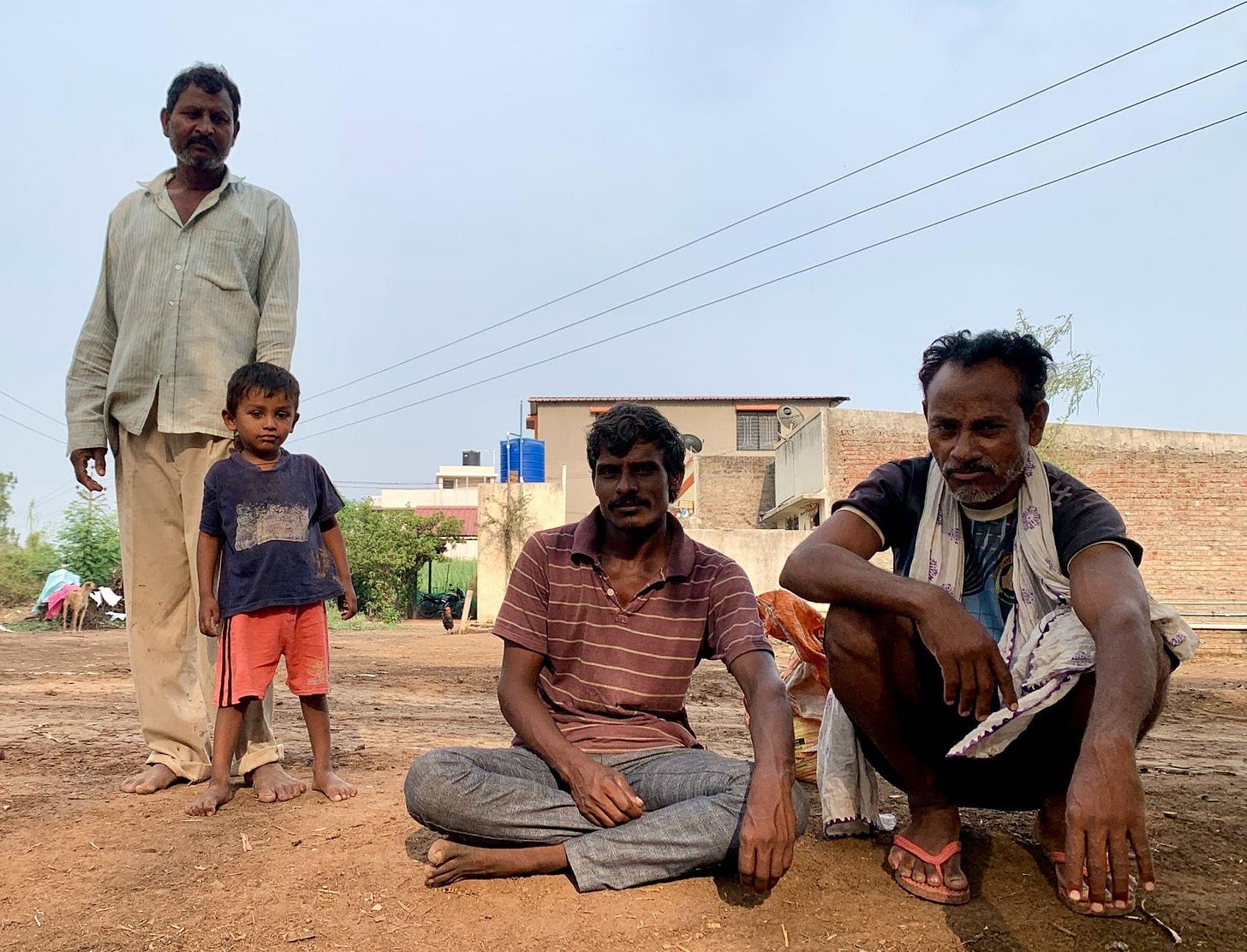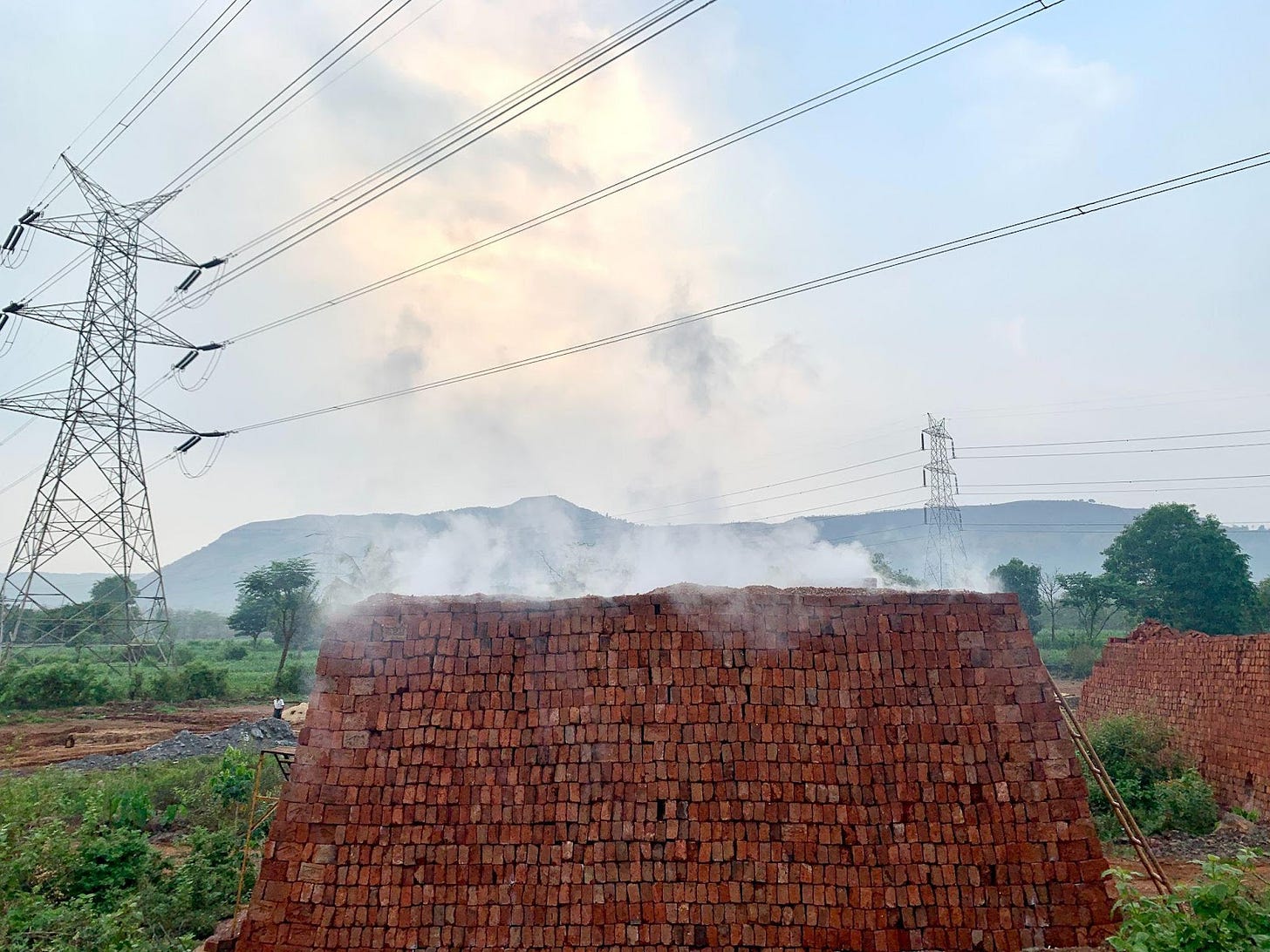It was 2 pm, the heat intensifying as I trudged along the roadside where only a few trees offered shade. Barbed wires on each side added to the unwelcoming atmosphere. Battling fatigue with each step, my legs threatening to give up, I spotted a narrow opening on a farm, a seemingly kind gesture from the owner for occasional passersby like me. Removing my harness attached to the trolley, I lay on the ground.
Thoughts of the next meal danced in my mind, but I knew there was nothing to be found for the next 7 km. The road, surrounded by numerous brick factories, revealed the towering structures creating intricate patterns. The scent of burnt earth permeated the air. Across the road, a Jeep, a truck, and another brick factory stood. A small house made of silver metal sheets hosted people, presumably having their lunch.
As I sat quietly, sipping water, a man appeared before me.
“Who are you? Where are you going?” he asked, doubt lingering in the air.
After explaining my walk's purpose, he signalled some friends to join us.
“Do you work in the brick factory?” I inquired.
“Yes,” came his soft and almost inaudible reply.
“Your walk seems incredible and difficult than the one we were on during covid,” he added.
Other men from the factory gathered, each with a unique story.
“Where did you start? How did you get back home?” I asked.
"From Mumbai. We walked all the way to Nashik. Some days we’d find food, and on others, we slept hungry. Our destination was our village in Vidarbha. My feet were swollen," one man gestured, sharing his experience. "A few people were kind and spared us money and food. I'll never forget the day I reached home. I cried in front of my mother."
Another man from the brick factory joined us.
“Did you have a similar experience?”
“Yes. I was in Pune when the pandemic happened. My factory shut down abruptly, and I was asked to leave. I walked all the way to Pusad with my 4-year-old kid and wife,” he replied calmly.
“You are going to Nagpur? You should visit my village in Pusad,” he added.
Meanwhile, Raj, the one I spoke with before, had disappeared briefly and returned with a paper and tiffin.
“You must be hungry. This is our lunch. My wife has added some mango pickle and onions. Do you eat Bhakri?” he asked.
Almost bewildered by their kindness, I spread my hands to accept whatever they brought.
“So how do you end up in Umbraj of all places?” I asked, eager to understand what brought them here.
Umbraj is some 800 km from Nagpur, and many people migrate from Vidarbha to bigger cities or sugarcane fields in southern Maharashtra.
“I left my house when I was 9. We have a bit of land, but it’s of no use—a dry patch in a drought-ridden area. With no other option, I started working on sugarcane farms. My dad did the same. We never went to school, so we couldn't read or write. I get stupefied in a city. This work here is good. I get a decent pay. The owner comes to our village and the neighbouring villages once a year, picks the best families suited for the brick factory, pays them upfront, and we commit to this job from then onwards. That’s how things work in our part of the world,” he explained, looking down at the ground.
The revelation that a man comes and selects families for work, paying cash upfront, sent shivers down my spine. It was added that there were no specific work hours—day or night, work continued. Thousands of farmers from Vidarbha leave their ancestral lands for a better future in cities or factories like these, leaving behind their culture, language, and lifestyles. Witnessing kids playing around the factory, I pondered on their inevitable fate—growing up in these circumstances, destined to be manual laborers in our cities. I could visibly feel the pain and hurt that they were experiencing each day, and still living with a smile on their faces. India is equal to everyone, they say. It’s not. There are gaps of decades between me and these workers and will continue to persist for generations if their kids don’t get educated.
“How much do you get paid?”, I asked
“I got paid forty thousand. For the entire family. My wife works when I sleep. That’s four months of work”, he said.
Another man, a driver delivering bricks from the factory to the city, chimed in, “It’s good pay”.
The men sitting in front of me had torn clothes, heads balding prematurely in their thirties, and sweat dripping from their arms and legs with mud stains all around, happily reciting their stories, as if this was common knowledge to all people. I turned around, to check the same brick factory with a fresh perspective. I saw a woman, who could very well have been Raj’s wife, walking up a 3 storey pile of bricks, with a sack filled with earth. An old man, in his 70’s, was pushing a trolley filled with bricks towards a warehouse. A dozen women had formed a chain shoveling earth and racking it up in piles. A man, presumably the owner of the jeep, and the farm, watched from a distance, scolding and checking that no one stopped.
In an instance, I could visualize each and every house I had passed by, knowing that I had never really seen the pain and suffering of drought-ridden farmers from Vidarbha, each brick painted with their hardship. The facade on the outside had successfully hidden the efforts of these farmers who were left with no other option than to live a life of misery.
“Should I bring some more?”, as I drifted in my thoughts, a voice interrupted me.
“No. This should do”, I said with a sense of gratitude.
I stayed a while, talking about their dreams alongside the rhythmic waving of the sugarcane fields and left on the road with a nourished belly.
In the coming days, I surfed on the internet to check the articles on the brick industry in India, and to my surprise (or not), I found that everyone had talked about the rising demand for bricks in India. In various publications, they spoke of factors driving the demand and challenges faced by the industry, but nowhere did they speak or even mention the makers of this brick. It has been so in modern India, that the buildings, architecture and booming infra is praised for bringing India up onto the world stage, but the men and women and frankly minors working in the infra and building sector are forgotten as if they did not ever exist. A simple google search with the words, “death” “brick kiln” “india”, paints a dramatic picture, where you may find many news reports of workers including minors succumbing to death by asphyxiation or even suffocation. According to the government data from 2023, over 3000 kiln workers have been found dead in the past three years. The Factories Act of 1948 has strict health and safety provisions that are put in place (on paper). These requirements are supposed to be enforced by the Chief Inspector of Factories (CIF) and Director of Industrial Safety and Health (DISH), but it has been found time and again that these positions are often misused.
From what I have heard from numerous workers during this walk, time and again, is that the Inspector lodges complaints that often suit the companies, many times blaming the workers and not the lapses in security and health by the factories. The police then help to soften the company image by putting in a news report that demonizes the deceased or the injured, marking it their problem and not of the company.
Now one might ask, how is that possible?
The ground reality is that these factories and companies often pay the newspapers for their advertisements, which makes a huge revenue stream for newspapers. The CSR funds of factories often give donations to the local Police institutions in building their police stations. These are often under the table arrangements which do not count as a bribe. In fact, these are legal ways to bribe institutions. None of this is new, but before it used to be reported and these days it's out of news cycles. That’s the only difference.
As I delved deeper into the shadows cast by the booming construction industry, the question that lingered was not just about the unspoken struggles of those moulding bricks, but a broader query that echoed through the halls of our society:
How can progress truly be measured when the very foundation of our cities is laid upon the silent sacrifices of those obscured from view? When the tales of suffering are swept aside, replaced by headlines that shift blame and shadows that mask truth, can we claim genuine advancement?
In a world where newspapers dance to the tunes of corporate coffers and police stations owe their existence to the generosity of those they should regulate, what future are we building? A future that crumbles under the weight of concealed realities, or one that rises with the collective acknowledgment of every life that contributes, knowingly or unknowingly, to the structures we applaud?
Perhaps the true measure of a nation's progress lies not just in the soaring skyscrapers that grace its skyline but in the stories etched in every brick, the lives entwined within each foundation. Until we pause to recognize the hidden hands behind our urban dreams, the question remains hanging, challenging the very essence of our pursuit of growth and development.












